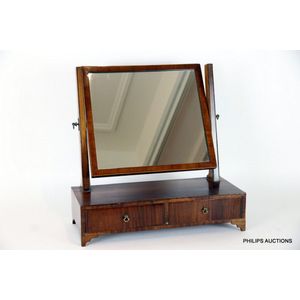Georgian Mahogany Shaving Mirror with Drawers
You must be a subscriber, and be logged in to view price and dealer details.
Subscribe Now to view actual auction price for this item
When you subscribe, you have the option of setting the currency in which to display prices to $Au, $US, $NZ or Stg.
- Bracket Feet - On bracket feet the corner edge is square and joined by a mitre to its partner on the opposite angle. The inner edge is usually shaped or scalloped. Bracket feet were first introduced in the early 18th century and used until c. 1830 and are found on carcase furniture such as chests, cabinets, bookcases and bureaux.
Ogee bracket feet, a variation on straight bracket feet, have the outside edge forming an "S" shaped curve with the top bulging outward and the bottom turning inward.
On splayed bracket feet, the exterior edge curves outward. - Georgian - As an English stylistic period, Georgian is usually taken to cover the period from George I (1714) to the Regency of Prince George (1811-20), although the period from 1800 to 1830 is sometimes designated as the Regency period. During the Georgian period the great English cabinetmakers and designers such as Chippendale, Hepplewhite, Adam Sheraton etc., were all active.
Therefore there isn't a single 'Georgian style' as such and to say something is 'Georgian', usually means it was made between 1714 and 1830. This assumes we discount George V and George VI, both being from the 20th century.
The styles popular at the time of each reign were:
George I (1714-1727) saw out the last years of the Baroque period.
George II (1727-1760) reigned during the Rococo period.
George III (1760-1820) saw the last gasp of the Rococo, all of the early Neo-Classic 'Adam style' and most of the later neo-Classic 'Regency style'.
George IV (Prince Regent 1820-1830)encompassed the last of the 'Regency' style.
William IV's reign (1830-1837) was something of a no man's land (stylistically) and he wasn't a 'George' anyway. He covered the last glimmerings of 'Regency' and the start of the 'Victorian' style. - Cross Banding - A decorative veneer, up to about 2 cm wide, laid at right angles to the parallel grain of the main carcase, continuing around the edge of the piece, used around the edges of table tops, drawer fronts, tops of chests and desks, and sometimes on door frames. The cross band may be either in the same or contrasting timber to the carcase and the joint may be sometimes hidden by a line of stringing or herring-bone banding. Cross banding is found on furniture constructed both of solid and veneered timber. Where solid timber is used, a rebate will have to be cut to accommodate the cross band, so that the upper surface of the piece is flush. However, due to the natural shrinkage of timber over the years, the cross banding will have been pushed up in places, and the joint can be felt by the fingertips. If the cross banding is completely flush or even countersunk below the surface of the carcase and shows no other evidence of strain, it may very well have been a more recent addition.
- Circa - A Latin term meaning 'about', often used in the antique trade to give an approximate date for the piece, usually considered to be five years on either side of the circa year. Thus, circa 1900 means the piece was made about 1900, probably between 1895 and 1905. The expression is sometimes abbreviated to c.1900.
- Mahogany - Mahogany is a dense, close grained red-coloured timber from the West Indies and Central America. It was first imported into Europe in the the early 18th century and its use continued through the 19th century. It was popular for furniture making because of its strength, the wide boards available, the distinctive grain on some boards, termed flame mahogany and the rich warm colour of the timber when it was polished.. The "flame" was produced where a limb grew out from the trunk of the tree, and this timber was usually sliced into veneers for feature panels on doors, backs and cornices.
Some terms used to describe mahogany relate to the country from which it originally came, such as "Cuban" mahogany, "Honduras" mahogany etc. However unless the wood has been tested the names assigned are more a selling feature, rather than a true indication of the timber's origin. - Boxwood - Boxwood is a hard, yellow coloured, close grained timber. In the 19th century it was often used for inlays, especially stringing, because of its contrasting colour to the darker timbers of the carcase. Stringing is the inlay of a narrow strip of veneer of a lighter colour, such as boxwood along or close to the edges of an object that has been veneered in a darker timber such as mahogany.
Because of its fine grain and resistnce to splitting or chipping it has also been used for treen, turnings, carvings and other small wooden items, such as chess pieces.
This item has been included into following indexes:
Visually similar items

A George III satinwood strung dressing mirror, English, 19th century. 66 cm high, 66.5 cm wide, 30 cm deep

George III mahogany toilet mirror with bevelled glass and three drawers on ogee bracket feet early 19th century, 64 cm height, 45 cm length, 23 cm depth, missing one foot

An unusual copper bound shop display cabinet fitted with 4 drawers on the reverse. Tasmanian oak, copper & glass, early 20th century (later casters). Height 104 cm, width 76.5, depth 60.5 cm

A late Georgian mahogany bow front dressing table mirror. Height 60 cm. Width 61 cm. Depth 24 cm
